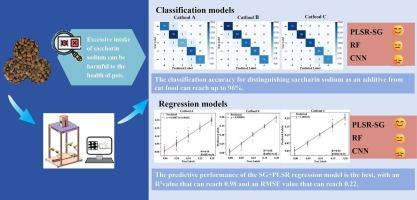Hyperspectral imaging and machine learning-based classification and quantification of sodium saccharin in cat food powder
IF 4.9
2区 化学
Q1 CHEMISTRY, ANALYTICAL
引用次数: 0
Abstract
Sodium saccharin is a synthetic sweetener occasionally added illicitly to pet food to improve palatability, yet its overuse poses health risks to companion animals. In this work, we evaluate near infrared hyperspectral imaging combined with machine learning for rapid, non-destructive quantification of sodium saccharin in ground cat food. Fifteen samples—three commercial formulations each spiked at 0, 0.05, 0.10, 0.15, and 0.20 wt% saccharin—were imaged, and mean spectra were extracted from regions of interest. Spectral preprocessing (Savitzky–Golay smoothing, standard normal variate, autoscaling) was applied to mitigate noise and scattering. We constructed qualitative and quantitative models using partial least squares regression (PLSR), random forest (RF), and a one-dimensional convolutional neural network (CNN). Among these, the SG-preprocessed PLSR model achieved the best performance on an independent test set, with calibration R2 of 0.99, prediction R2 of 0.98, RMSE_C = 0.08 wt%, and RMSE_P = 0.22 wt%. These results demonstrate that SG + PLSR is the optimal model across the three sample sets Therefore, SG + PLSR provides a robust approach for monitoring sodium saccharin adulteration in pet food. Our methodology offers a promising platform for inline quality control in feed manufacturing.

猫粮粉中糖精钠的高光谱成像与机器学习分类定量研究
糖精钠是一种人工合成甜味剂,偶尔会被非法添加到宠物食品中,以提高其适口性,但它的过度使用会给宠物带来健康风险。在这项工作中,我们评估了近红外高光谱成像结合机器学习对磨碎猫粮中糖精钠的快速、无损定量。对15个样品(3个商业配方,各添加0、0.05、0.10、0.15和0.20 wt%糖精)进行成像,并从感兴趣的区域提取平均光谱。采用光谱预处理(Savitzky-Golay平滑、标准正态变量、自缩放)来减轻噪声和散射。我们使用偏最小二乘回归(PLSR)、随机森林(RF)和一维卷积神经网络(CNN)构建了定性和定量模型。其中,sg预处理的PLSR模型在独立测试集上表现最佳,校正R2为0.99,预测R2为0.98,RMSE_C = 0.08 wt%, RMSE_P = 0.22 wt%。这些结果表明,SG + PLSR是三个样本集的最佳模型,因此,SG + PLSR为监测宠物食品中的糖精钠掺假提供了一种可靠的方法。我们的方法为饲料生产中的在线质量控制提供了一个有前途的平台。
本文章由计算机程序翻译,如有差异,请以英文原文为准。
求助全文
约1分钟内获得全文
求助全文
来源期刊

Microchemical Journal
化学-分析化学
CiteScore
8.70
自引率
8.30%
发文量
1131
审稿时长
1.9 months
期刊介绍:
The Microchemical Journal is a peer reviewed journal devoted to all aspects and phases of analytical chemistry and chemical analysis. The Microchemical Journal publishes articles which are at the forefront of modern analytical chemistry and cover innovations in the techniques to the finest possible limits. This includes fundamental aspects, instrumentation, new developments, innovative and novel methods and applications including environmental and clinical field.
Traditional classical analytical methods such as spectrophotometry and titrimetry as well as established instrumentation methods such as flame and graphite furnace atomic absorption spectrometry, gas chromatography, and modified glassy or carbon electrode electrochemical methods will be considered, provided they show significant improvements and novelty compared to the established methods.
 求助内容:
求助内容: 应助结果提醒方式:
应助结果提醒方式:


